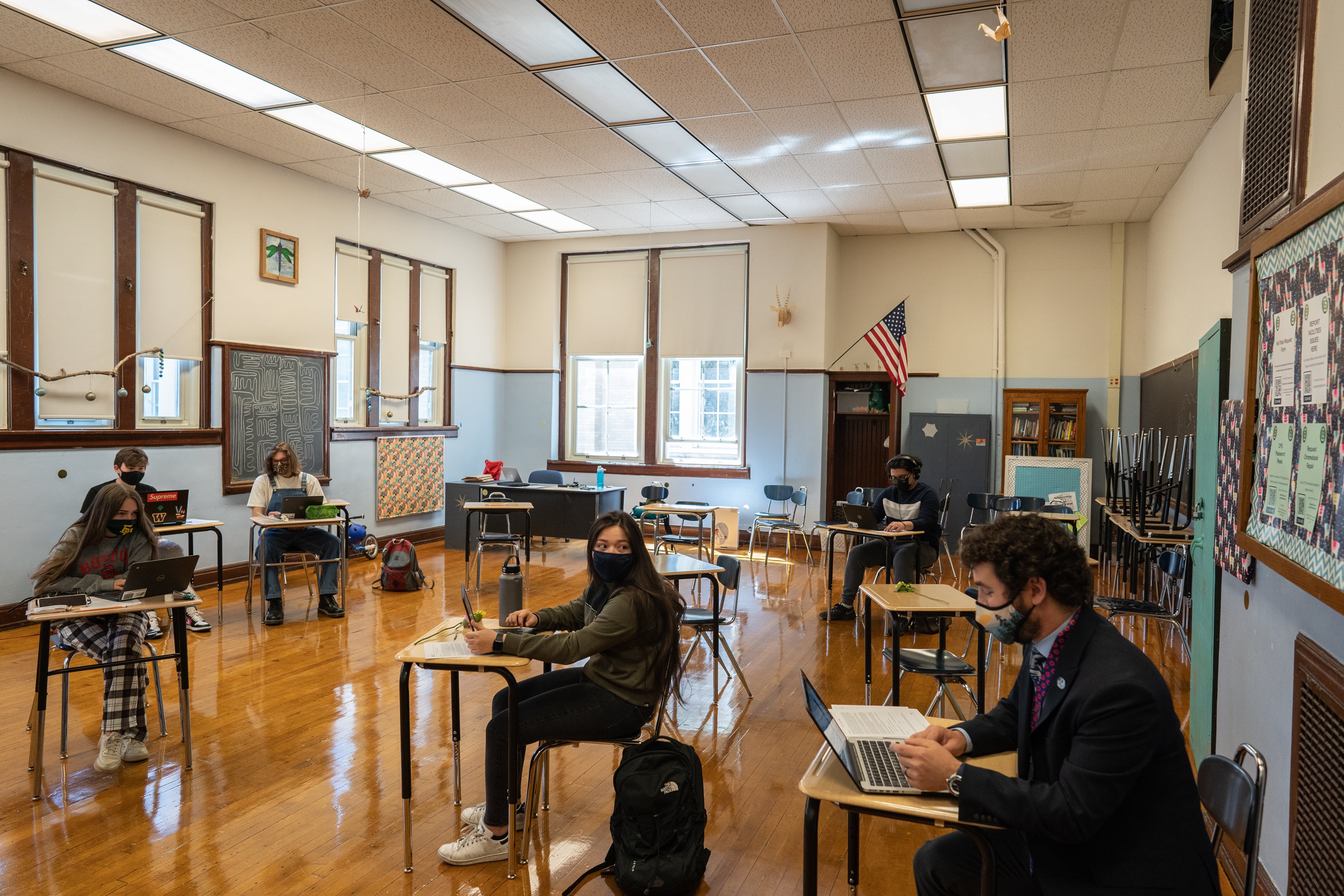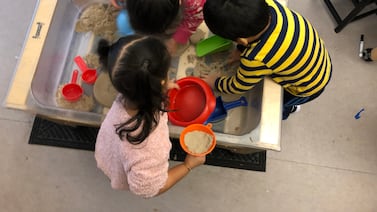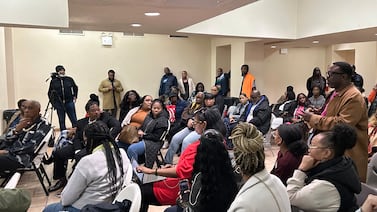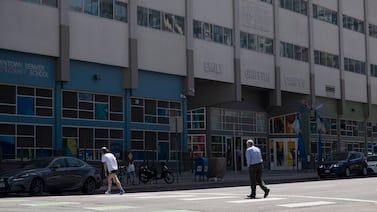Joanna Su has seen some of the federal COVID relief dollars Chicago Public Schools budgeted this school year trickle down to her sixth grader’s elementary school in the Rogers Park neighborhood.
With the money, Gale Community Academy, where students are overwhelmingly low-income, hosted family events this fall that helped it to start rebuilding a sense of community after a largely virtual school year. It paid for a substitute teacher to free up educators for “invaluable” time to plan and troubleshoot together. But Su, who serves on the Local School Council, has also wondered: How did the district arrive at the modest $38,000 it passed on directly to the school? What other help is the campus getting?
Over the summer, the district gave $47 million to its roughly 500 campuses, allowing them to spend the money as they saw fit to address the pandemic’s academic and mental health fallout. Those flexible “unfinished learning” dollars are a tiny fraction of the more than $1 billion in COVID relief funds the district budgeted this school year — part of an unprecedented influx in federal resources meant to help schools respond and recover from the outbreak. But almost halfway through the school year, these dollars are the only portion of that funding for which the district can provide a campus-by-campus breakdown.
District leaders stress that the bulk of the money is helping schools directly — by paying for COVID safety measures, keeping teaching positions at shrinking schools from the chopping block and powering a slew of academic and mental health interventions.
“I really want to emphasize that all of these dollars are either living in schools or supporting students with needs coming out of the pandemic,” said Michael Sitkowski, assistant budget director, at a virtual budget forum earlier this month.
The district’s central office is overseeing that spending, making it harder to account in real time for how much each campus is receiving. And the spending is ongoing, officials said — with the district stepping in to address needs and cover expenses as they arise — with more school-level data coming at the end of the year.
But the lack of a real-time window into how federal dollars are helping individual campuses has fueled questions from some principals and parents. The district’s teachers union has increasingly argued that some high-need campuses are not getting enough help. At a November press conference to highlight staffing challenges and turnover at a North Lawndale elementary school, union President Jesse Sharkey argued the federal money is “not showing up” at some schools.
School districts and states across the country are facing increasing calls for more transparency on how they are spending the federal pandemic recovery dollars in real time — even as some education leaders counter that up-to-the-minute data reporting requirements are unrealistic and would hamper district efforts to navigate the ongoing crisis. In Chicago, schools chief Pedro Martinez, who stepped in this past fall after crafting an aggressive COVID relief spending plan as San Antonio’s superintendent, has pledged transparency and metrics to track results.
Marguerite Roza, director of the Edunomics Lab at Georgetown University, says some districts are controlling 100% of those federal dollars centrally, and many have offered poor visibility into actual spending so far.
“It’s a smart move to give some of the money directly to schools,” she said about Chicago’s flexible funds. “But this is a very, very modest amount.”
Tackling the pandemic’s fallout
Since the spring of 2020, the federal government has given school districts three infusions of pandemic relief dollars, the bulk of which are known as Elementary and Secondary School Emergency Relief funding, or ESSER. That culminated last spring with the Biden administration’s American Rescue Plan, which includes a historic influx of federal dollars for schools.
Adding up the three packages, Chicago received almost $2.8 billion. The $1.06 billion in this school year’s budget comes from the second and third packages — factoring in earlier spending, that leaves more than $1.1 billion to be spent in the next two years.
Last spring, the district announced its two-year Moving Forward Together initiative to tackle academic and social-emotional damage from the pandemic. The flexible “unfinished learning” dollars are part of the $267 million budgeted for the plan this school year.
To allocate them, the district used a new Unfinished Learning School Investment Index — a complex formula that uses student demographics, campus metrics such as teacher retention, and the local impact of COVID and gun violence.
Earlier this fall, Chalkbeat submitted a Freedom of Information Act request for the total amounts of federal pandemic relief dollars each school in the district was slated to receive this school year. The “unfinished learning” allocations were the only numbers the district was able to provide.
That’s not all the ESSER help schools are receiving. But the bulk of the Moving Forward Together funding lives in the district’s central office budget, which schools can tap separately for academic and mental health interventions selected out of a district menu.
The district did provide lists of those interventions that each school opted to receive. But it could not say how much these supports cost to implement at each school, and some principals said the district is still rolling out some of them. Based on the district’s data, the most popular programs were a digital platform for tracking personalized academic support, a new suite of standardized tests called Star 360 and a structured reading training program.
According to the flexible funding data the district provided, schools received about $92,000 in such funds on average, or about $196 per pupil. Schools in the Fuller Park, North Lawndale, Rush & Division, Grand Crossing and Englewood neighborhoods received the highest per pupil amounts; campuses in Sheffield & DePaul, Montclair and Boystown got the most modest allocations.
Two principals who spoke with Chalkbeat on the condition of anonymity said they had to come up with spending plans for these flexible dollars on a tight timeline over the summer, with no expectation that they solicit input from the local councils that weigh in on budgets at most district-run schools and using a template that was hard to navigate.
“A ton of principals were really frustrated by that process,” one principal at a high school that serves a high-need student population said. “You didn’t get a chance to build community around this spending.”
Both principals said they used the bulk of the dollars for long-standing student programs already in their school budgets, freeing up money for other projects or to plug budget holes.
“We just shifted things around,” an elementary school principal said. “The ESSER money is not to plug budget holes. It’s to do additional recovery work. ”
But at Manierre Elementary, Principal Tinishi Davis said the federal funding has powered just this kind of additional support to help students bounce back from the pandemic. The school, which serves predominantly Black and low-income students in Old Town, got $53,000 in flexible dollars. After consulting educators and the Local School Council, Davis decided to hire a teaching assistant, mainly to help pull out struggling young readers for extra phonics instruction.
But Davis, who also oversees the Ferguson Child Parent Center, stresses these flexible dollars are just a portion of the help schools like hers are getting. With ESSER funds, the district beefed up the school’s “equity grant” — allocations that Chicago Public Schools has used in recent years to prop up the budgets of campuses with declining enrollment. With the extra grant money, the school was able to hire a world language teacher for the first time.
Then, there are the centrally funded Moving Forward Together interventions. In November, the first tutor arrived through a new Tutor Corp the district is launching this year, and by mid-December, three tutors were helping teachers catch up students on early reading skills. The campus got a new social-emotional curriculum as well as professional development and a consultant to help with implementing the district’s new Skyline curriculum.
“We are grateful for the resources we were given to address academic and social-emotional needs this year,” Davis said. “I truly feel we as a district are moving forward together.”
In response to a Chalkbeat records request for all school “unfinished learning” plans, the district provided documents for about 50 of its 500 campuses. That sample suggests many schools stressed interventions to catch up students on math and reading skills — by hiring a teaching assistant, providing professional development for educators, freeing up more time for planning or rolling out new assessments to guide that instruction. Another catch-all category was social and emotional learning, with schools chipping in for new curriculums and, in one case, a new quiet space and an after-school yoga class for employees.
This fall, school board members have pressed officials to spell out how they will gauge whether the ESSER investments are paying off for students — metrics district leaders have promised but haven’t yet delivered. One school, Ortiz de Dominguez in Little Village, set some measurable goals in its plan to track the payoff from its interventions, including a 40% decrease in the number of students receiving Ds and Fs, and a 10% increase in attendance at parent-teacher conferences.
But it appears there was no general expectation to measure progress in this way.
How much spending at each campus?
In a recent Edunomics Lab webinar, researchers noted that districts and states are facing intensifying calls to show their cards on their ESSER spending. Those demands have come from Congress and the federal Department of Education’s watchdog agency, which has decried a dearth of solid data in real time.
Chicago has offered a breakdown of the $1.06 billion in COVID relief dollars in this school year’s budget in several broad categories. In addition to Moving Forward Together, about $132 million was earmarked for student reengagement efforts and school reopening costs, including safety measures such as personal protective equipment, testing and technology. Another $100 million went to school air quality improvement projects.
Roughly $288 million went into “programmatic investments,” which included additional special education positions at some schools, larger “equity grants” and extra dollars to speed up the district’s early childhood education expansion. Another $178 million was budgeted to spare teaching and support staff positions from layoffs amid declining enrollment. Finally, charter and contract schools, which were entitled to a portion of the money under federal guidelines, received another $95 million.
But how much money did each campus get in each of those categories? Apparently, it’s difficult to say — because the money was budgeted centrally rather than divvied up among schools at the start of the year, and because those expenses are ongoing, in some cases guided by needs that may arise throughout the school year.
Some principals argue school leaders should have more direct control over a larger portion of these resources. The elementary school principal who spoke with Chalkbeat anonymously said way too many COVID safety signs and too many coronavirus tests arrived at his school. He would have liked to use more federal dollars for home visits to help troubleshoot barriers to attendance, steering families to housing, food and other resources.
With little visibility into the spending in real time, he said, “The principals are all asking: ‘Where’s the money going?’”
Pavlyn Jankov, a researcher at the Chicago Teachers Union, says having a list of Moving Forward Together programs at each campus is helpful, but without a price tag for each school, how can the public make sure that spending is equitable? Are these programs actually deployed — or do hiring challenges for the district and its outside vendors in some cases mean that interventions are not yet in place? How much of the funding is merely offsetting routine spending that was slated to happen regardless of the pandemic?
“Those are big questions, and we have zero information about that,” Jankov said. “We won’t know until after that fact.”
Roza at Edunomics Lab says she is a proponent of keeping more funding closer to the schools. In some cases, central administrators might decide that each campus should get a reading coach, for instance — even as some are struggling with attendance this fall and actually need a staffer to step up outreach to families. More flexible funds would also allow schools to meet challenges as they arise, such as setting up child care and activities for kids on Vaccination Awareness Day.
In Chicago, principals will do a mid-year analysis of how things are going with Moving Forward Together in January and start planning for next year. Davis, the Manierre principal, is already working on a wish list, including devices for students both at home and at school for an easy shift to remote learning on snow days.
The district has planned markedly higher flexible dollar allocations for next year. Said Davis, “I’m elated about that.”






